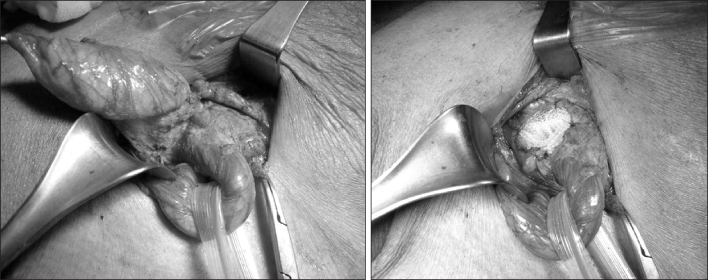J Korean Surg Soc.
2009 Sep;77(3):184-188. 10.4174/jkss.2009.77.3.184.
Patterns of Recurrent Hernias according to the Types of Previous Hernioplasties
- Affiliations
-
- 1Department of Surgery, College of Medicine, Chungbuk National University, Cheongju, Korea. webjwpark@chungbuk.ac.kr
- KMID: 2004217
- DOI: http://doi.org/10.4174/jkss.2009.77.3.184
Abstract
- PURPOSE
Recently, conventional tissue repairs are gradually being replaced by tension-free hernioplasties using meshes (mesh repairs) in hernia surgery. The aim of the present study was to evaluate patterns of recurrent hernias according to the types of previous hernioplasties. METHODS: From August 2005 to July 2008, 18 hernioplasties were performed in recurrent cases at Chungbuk National University Hospital. All previous hernioplasties were performed at local hospitals except one case of ventral hernia. We reviewed the medical records and compared clinical features according to the types of previous hernioplasties. RESULTS: Among the 18 recurrent hernias, there were 15 inguinal including 2 pediatric cases, an umbilical, and 2 incisional hernias. Among 13 adult inguinal recurrent cases, 5 occurred after tissue repair (3 indirect, 1 direct, and 1 pantaloon type) and 8 after mesh repairs (direct type in all). Recurrence developed earlier after mesh repairs than tissue repairs (median [min~max]; 24 [0.1~164] vs. 243 [60~360] months, P=0.005). Other types of recurrence developed between 6 to 48 months after previous operations. Recurrent hernias after mesh repairs occurred preferentially along the margin of previous meshes. All cases were treated by mesh repairs except in pediatric cases. Median operation time and hospital stay for recurrent inguinal hernias were not different significantly by previous operations. Postoperative complications were minimal without recurrence during a median 5.5-(1.5~25.5)-month follow-up. CONCLUSION: Recurrent hernias develop both after tissue repairs and mesh repairs. After mesh repairs, recurrences develop earlier and are more often associated with technical failure compared to tissue repairs.
MeSH Terms
Figure
Reference
-
1. Bassini E. Nuovo metodo per la cura radicale hernia inguinale. Atti Conger Assoc Med. 1887. 2:179.2. Awad SS, Fagan SP. Current approaches to inguinal hernia repair. Am J Surg. 2004. 188:9S–16S.3. Lichtenstein IL, Shulman AG. Ambulatory outpatient hernia surgery. Including a new concept, introducing tension-free repair. Int Surg. 1986. 71:1–4.4. Postlethwait RW. Causes of recurrence after inguinal herniorrhaphy. Surgery. 1971. 69:772–775.5. Lichtenstein IL, Shulman AG, Amid PK, Montllor MM. The tension-free hernioplasty. Am J Surg. 1989. 157:188–193.6. Barrat C, Surlin V, Bordea A, Champault G. Management of recurrent inguinal hernias: a prospective study of 163 cases. Hernia. 2003. 7:125–129.7. Amid PK, Shulman AG, Lichtenstein IL. Open "tension-free" repair of inguinal hernias: the Lichtenstein technique. Eur J Surg. 1996. 162:447–453.8. Klinge U, Zheng H, Si Z, Schumpelick V, Bhardwaj RS, Muys L, et al. Expression of the extracellular matrix proteins collagen I, collagen III and fibronectin and matrix metalloproteinase-1 and -13 in the skin of patients with inguinal hernia. Eur Surg Res. 1999. 31:480–490.9. Wagh PV, Read RC. Collagen deficiency in rectus sheath of patients with inguinal herniation. Proc Soc Exp Biol Med. 1971. 137:382–384.10. Ajabnoor MA, Mokhtar AM, Rafee AA, Taha AM. Defective collagen metabolism in Saudi patients with hernia. Ann Clin Biochem. 1992. 29(Pt4):430–436.11. Bay-Nielsen M, Nordin P, Nilsson E, Kehlet H. Danish Hernia Data Base and the Swedish Hernia Data Base. Operative findings in recurrent hernia after a Lichtenstein procedure. Am J Surg. 2001. 182:134–136.12. Amid PK. The Lichtenstein repair in 2002: an overview of causes of recurrence after Lichtenstein tension-free hernioplasty. Hernia. 2003. 7:13–16.13. Balen E, Ferrer J, Vicente F, Blazquez L, Herrera J, Lera J. Recurrences after prosthetic repair of inguinal hernias by the Lichtenstein technique. Hernia. 2000. 4:13–16.14. Richards SK, Vipond MN, Earnshaw JJ. Review of the management of recurrent inguinal hernia. Hernia. 2004. 8:144–148.15. Amid P. Classification of biomaterials and their related complications in abdominal wall hernia surgery. Hernia. 1997. 1:15–21.16. Klinge U, Junge K, Stumpf M. Causes of recurrences after Lichtenstein tension-free hernioplasty. Hernia. 2003. 7:100–101.17. Luijendijk RW, Lemmen MH, Hop WC, Wereldsma JC. Incisional hernia recurrence following "vest-over-pants" or vertical Mayo repair of primary hernias of the midline. World J Surg. 1997. 21:62–65.18. Rutkow IM, Robbins AW. Demographic, classificatory, and socioeconomic aspects of hernia repair in the United States. Surg Clin North Am. 1993. 73:413–426.19. Schaap HM, van de Pavoordt HD, Bast TJ. The preperitoneal approach in the repair of recurrent inguinal hernias. Surg Gynecol Obstet. 1992. 174:460–464.20. Thieme ET. Recurrent inguinal hernia. Arch Surg. 1971. 103:238–241.21. Nam SY, Lim JT, Choi YB. A tailored approach for recurrent groin hernias. J Korean Surg Soc. 2008. 74:134–139.22. Motson RW. Why does NICE not recommend laparoscopic herniorraphy? BMJ. 2002. 324:1092–1094.23. Ha YH, Yoon JS, Chang MC, Lee CH, Namgung H, Park YC, et al. Clinical analysis of recurrent inguinal hernias. J Korean Surg Soc. 2005. 69:252–258.24. Wantz GE. Schwartz SI, Shires GT, Spensor FC, editors. Abdominal wall hernias. Principles of Surgery. 1999. 7th ed. New York: McGraw-Hill;1586–1599.


